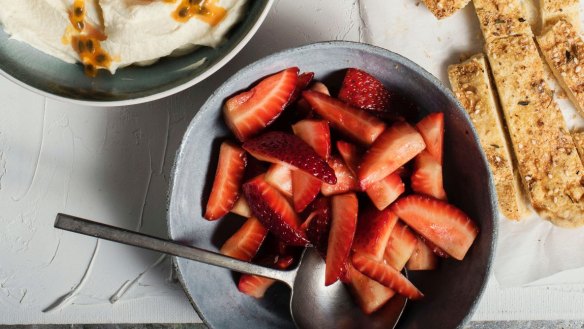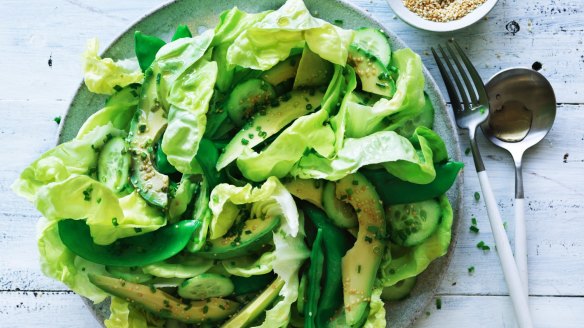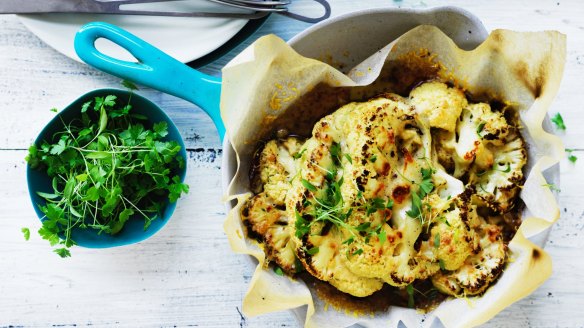Six affordable fresh fruits and vegies you can eat to your heart's content through spring

With many of us preparing more food at home and spending a lot more time in supermarkets, you may have noticed that some of our favourite fresh fruits and vegies are considerably cheaper right now.
This is a result of high supply and reduced demand from restaurants and cafes. The good news for home cooks is that we can enjoy more fresh Australian produce for a fraction of the price. And that can only be a good thing when it comes to our health and nutrition.
Strawberries
An especially nutrient-rich food, strawberries are particularly high in antioxidants, vitamin C and dietary fibre. An entire punnet contains fewer than 420 kilojoules, making them a perfect daily snack, light dessert option or baking ingredient to naturally sweeten cakes and muffins. You can also freeze strawberries for up to six months, so now is a great time to stock up while they are relatively cheap. Use your supply in healthy baking recipes, breakfast pancakes and smoothies. Or, if you are looking for some more indulgent options, teaming strawberries with 100 per cent nut spreads, dipping them in dark chocolate and serving on dessert or snack platters adds loads of flavour and nutrition.
Blueberries
One of the most nutrient-dense foods you can find, blueberries are specifically linked to improved cognitive function as we age. And with their exceptionally high antioxidant content, blueberries are a smart daily food addition, especially when they are selling for as little as $2 a punnet. Like strawberries, blueberries can easily be frozen so again now is a great time to stock up. They're rich in dietary fibre, vitamin C, vitamin K and the antioxidants anthocyanins, known for their protective health benefits. Blueberries are easy to snack on and can be added to salads, sweet treats and smoothies for a flavour and nutrition hit.

Avocado
A bumper crop coupled with far less smashed avo being served in cafes means you can grab this healthy fave for as little as $1 a pop. While high in fat, it is largely monounsaturated, or the type of fat that it is not associated with an increase in blood cholesterol levels. One small avocado contains about 850 kilojoules, 20 grams of fat and three grams of dietary fibre, plus loads of potassium, magnesium, folate and vitamin B. Avocados are also extremely filling, thanks to both their good fat and fibre content, which make them a great breakfast or lunch addition to help minimise snacking throughout the day. You also may not know that you can freeze avocado, especially while they are relatively cheap. All you need to do is cut or mash the flesh, add a little lemon juice and store in an air-tight container for four to six months.
- Katrina Meynink's five ways to make the most of bargain avocados
- 30 avocado recipes that are better than guacamole
Apples
We do not always think of apples as a superfood, but considering they are rated as one of the most filling foods you can eat, and contain less than 420 kilojoules while also offering a hearty dose of both soluble and insoluble fibre, there's a lot to be said for eating an apple a day. Whether you enjoy an apple as a satisfying snack with a little cheese or a handful of nuts, add it to a daily fruit and vegie juice or as a base to baked goods and protein balls, apples will keep fresh in a crisper for weeks, if not months. Another great way to use the wide range of apples selling for as little as a couple of dollars a kilo is to puree the fruit, which makes an extremely sweet puree. Use it to sweeten desserts and baked goods with a fraction of the sugar.

Cauliflower
In-season caulis are much cheaper than usual right now, making it a great time to stock up and enjoy in salads, stir-fries, vegie roasts or blitzed and made into a low-carbohydrate alternative to rice. They're a member of the brassica family, the group of vegetables renowned for their anti-cancer properties thanks to a group of nutrients called the glucosinolates and the isothiocyanates. Cauliflower is also exceptionally low in energy and high in dietary fibre, offering three grams of fibre per cup serve along with vitamins C, K, B6 and folate. Cauliflower can be frozen but you are best to blanch it beforehand to keep its nutrients and quality intact.
Red capsicum
Another superfood but one that can be extremely pricey, red capsicums are packed full of beta carotene (the precursor to vitamin A), vitamin C and dietary fibre as well as antioxidants, making it another smart daily food addition, especially for those battling inflammation. With prices a lot more reasonable at the moment, it is a great time to load your diet up with this nutrient-rich powerhouse. It is easy to incorporate capsicum into your favourite salads, stir-fries, curries or Mexican dishes, or simply enjoy as a snack with your favourite dip. You can also freeze red capsicum simply by slicing, removing the stem and seeds and sealing in an air-tight bag or container.
Susie Burrell is a nutritionist and dietitian.
The best recipes from Australia's leading chefs straight to your inbox.
Sign up